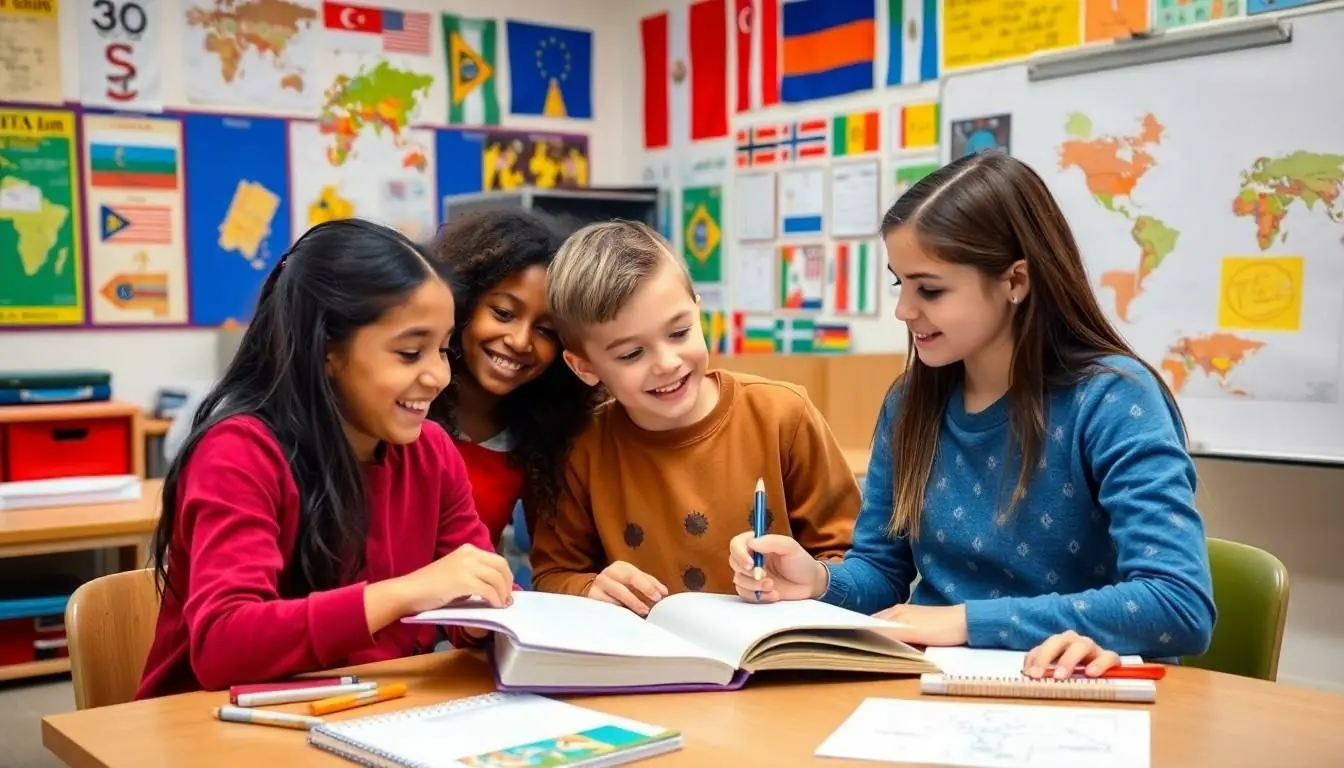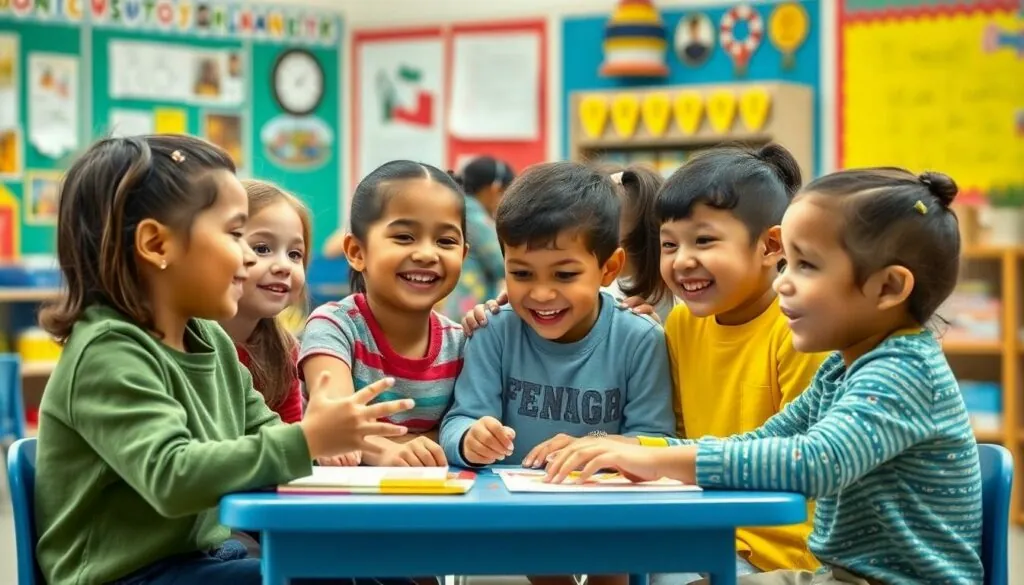In a world that’s more connected than ever, speaking just one language is like showing up to a potluck with only a bag of chips. Dual language learning isn’t just a trend; it’s a superpower that opens doors to new cultures, ideas, and even job opportunities. Imagine effortlessly switching between languages like a linguistic ninja, impressing friends and potential employers alike.
Table of Contents
ToggleOverview Of Dual Language Learning
Dual language learning refers to an educational approach that incorporates instruction in two languages. It aims to develop proficiency in both a native and a target language, ensuring students acquire literacy and academic skills in both languages. Research shows that students participating in dual language programs often outperform their peers in various academic measures.
Effective programs typically involve a 50-50 distribution of instruction in each language. This balanced approach promotes equal exposure, allowing students to become fluent in both languages. In such settings, it’s common to see students engaging with diverse content areas, integrating language skills across subjects.
Cognitive and social benefits emerge for students who learn in dual language environments. Studies indicate that bilingual individuals exhibit improved problem-solving skills, heightened creativity, and enhanced cognitive flexibility. They develop greater empathy and cultural sensitivity, which are essential in today’s globalized society.
Implementing dual language learning programs requires trained educators who understand both languages and curricula. Collaboration among teachers can strengthen program effectiveness. Communities play a significant role in supporting these initiatives, offering resources and cultural context to enrich learning experiences.
The increasing demand for bilingual professionals in the workforce highlights the relevance of dual language education. Employers value candidates who can communicate in multiple languages, improving chances for employment in diverse industries. Overall, integrating dual language learning in education prepares students for a successful future in an interconnected world.
Benefits Of Dual Language Learning

Dual language learning offers significant advantages for individuals in various domains. This educational approach equips students to thrive academically and socially.
Cognitive Advantages
Cognitive benefits emerge prominently in dual language environments. Improved problem-solving skills characterize bilingual learners, enabling them to analyze situations from different perspectives. Research indicates students in dual language programs often exhibit heightened creativity, which fosters innovative thinking. Enhanced cognitive flexibility allows them to switch between tasks and viewpoints seamlessly. Students develop stronger analytical skills, with bilingualism correlating positively with better performance on standardized tests. Emphasis on language complexity broadens their understanding of diverse concepts.
Social and Cultural Benefits
Socially, dual language learners gain essential interpersonal skills. Greater empathy emerges as students interact with peers from different cultural backgrounds. Understanding and appreciating diverse perspectives fosters cultural sensitivity, promoting inclusivity. Students in these programs often build lasting relationships across linguistic divides. Exposure to varied traditions enriches their social experiences, enhancing community engagement. Enhanced communication skills contribute to effective collaboration in diverse settings. Overall, dual language learning cultivates a sense of belonging while preparing students to navigate a multicultural world.
Challenges In Dual Language Learning
Dual language learning presents various challenges that can impact its effectiveness. Addressing these obstacles is crucial for creating successful educational environments.
Implementation Issues
Implementation of dual language programs often encounters several obstacles. Schools may lack properly trained educators who are proficient in both languages. Curriculum alignment can pose problems when integrating language and content standards together. Diverse student populations may complicate program delivery, requiring tailored strategies to meet different needs. Resistance from parents or community members can further hinder acceptance of dual language initiatives. Furthermore, consistent administrative support plays a vital role in maintaining program fidelity and ensuring ongoing development opportunities.
Resource Limitations
Resource limitations significantly affect the success of dual language education. Schools might struggle to secure adequate funding for materials and instructional resources that support bilingual learners. Limited access to bilingual books and technology can restrict students’ exposure to both languages. Professional development for educators may also receive insufficient investment, preventing teachers from enhancing their skills in dual language instruction. Additionally, logistical barriers may arise when scheduling classes in a way that maximizes exposure to both languages throughout the school day. These factors collectively challenge effective dual language implementation.
Effective Strategies For Dual Language Learning
Effective strategies enhance dual language learning by promoting engagement and proficiency. Implementing specific techniques in the classroom fosters an immersive language environment.
Classroom Techniques
Incorporating interactive activities enhances language skills. Teachers can use games, role-playing, and storytelling to foster engagement. Using visuals, such as charts and pictures, aids comprehension while learners practice speaking and writing. Integrating technology accelerates learning through language apps and online resources. Encouraging peer collaboration promotes language practice and builds confidence among students.
Family Involvement
Family involvement strengthens dual language learning. Parents can create a language-rich home environment by reading bilingual books and encouraging conversations in both languages. Regular communication between families and teachers supports students’ progress. Workshops designed for parents help them understand dual language benefits and strategies. Families participating in language-related cultural events foster community connections and reinforce learning at home.
Embracing dual language learning opens doors to a world rich in opportunities and experiences. It not only equips students with essential communication skills but also fosters a deeper understanding of diverse cultures. The cognitive and social advantages gained through this educational approach prepare learners to thrive in an increasingly globalized society.
Despite the challenges that may arise, the benefits of dual language programs are undeniable. With the right support and resources, schools can create environments where bilingualism flourishes. As the demand for bilingual professionals continues to rise, investing in dual language education is a step toward a brighter future for students and communities alike.






